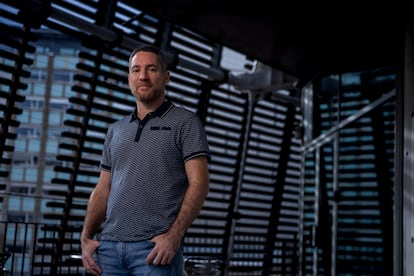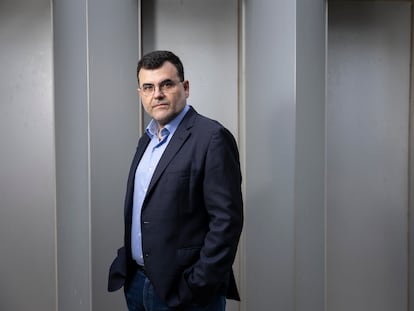The dawn of a new medicine: Researchers use the theory of evolution to fight cancer
The world’s first joint research program in evolutionary medical genomics has been launched in Barcelona, under the direction of biologist Manuel Irimia

If God had been a 19th-century physicist, he would not have played dice, but as a biologist he would have been a lifelong gambler. Living beings are the product of a random combination of genetic variants that give rise to individuals trying to survive in an ever-changing world. What offers an advantage in one context may become a liability in another. A tall man may be more sexually attractive than the small man or more likely to win a fight, but he also has a greater risk of dying sooner. Elephants have no predators, but they reproduce very slowly and as a species they are more fragile than the tasty gazelles. All the chaotic diversity of life would be meaningless, as the evolutionary biologist Theodosius Dobzhansky said, if it were not the light of evolution. This light has served to give meaning to life, and is now poised to shed light on health and disease.
This week, the world’s first joint research program in evolutionary medical genomics (EvoMG) was launched in Barcelona. The initiative, with initial funding of over $1 million from the Catalan regional government, is a collaboration between the Centre for Genomic Regulation (CRG), the Pompeu Fabra University (UPF) and the CSIC-UPF Institute of Evolutionary Biology (IBE). Its goal: to apply the principles of evolution to understanding the roots of disease in order to improve human health. “Part of this concept is what we call therapies resistant to evolutionary processes, which include cancer, bacteria, viruses or any pathogen, which will mutate and adapt to the treatment you apply,” explains Manuel Irimia, the project’s director and a research professor at the Catalan Institution for Research and Advanced Studies (ICREA).
Cancer follows the same evolutionary rules as living beings, but with fewer constraints — it is nature running amok. In living beings, mutations offer advantages that enhance survival in changing conditions, such as the genetic variant that allows Tibetans to utilize oxygen more efficiently. Tumor cells mutate at a dizzying speed, and this explains the rapid appearance of resistance to drugs. Treatments that initially work become ineffective as resistant cells proliferate. One of the groups involved in EvoMG — led by CRG researcher Donate Weghorn — studies cancer as an evolutionary system. Other teams are exploring ways to trap cancer in an evolutionary dead end.
Another area where evolutionary insights have immediate relevance is antibiotic resistance. After decades of triumphs against bacteria, antibiotics are losing effectiveness as microbes adapt. “This is one of the great challenges for public health and it is an evolutionary problem, we are fighting against pathogens that evolve very quickly. We are pitting the chemical and pharmaceutical industry against the evolution of bacteria, and I think that is a bad idea,” says Irimia.
Instead of searching for antibiotics by trial and error, evolutionary and mathematical models hold the potential to create more effective drugs. “At UPF, there is a virologist, Juana Díez, who is part of the program, who is developing a treatment that attacks secondary structures of the virus. From an evolutionary point of view, it is much more difficult for the virus to adapt to this treatment, because a single mutation is not enough, it needs a mutation in two places at the same time, and there are mathematical models that show you that this makes it much more difficult for it to become resistant. These are the types of ideas that we want to promote with this program,” says Irimia.
For this scientist, one of the main benefits of this initiative is to offer a new perspective to biomedical researchers: “These are people who work on very diverse problems and had not thought of applying these evolutionary principles. With this program, they can do so, and it is possible that they will find solutions that they would not have thought of otherwise,” says Irimia.

He knows the way but has traveled it in reverse. As an evolutionary geneticist, he has spent years studying how the same gene can produce different proteins with different functions. The humane genome seems to have been written by a riddle writer, who alternates intelligible words with meaningless ones. To extract useful information for protein production, cells rely on a process called splicing, which joins meaningful segments of genetic code. This mechanism allows a single gene to be read in multiple ways, enabling cells to produce diverse proteins with varied functions in our bodies — and contributing to the vast diversity of life on Earth.
While studying this genomic system, Irimia discovered small fragments of information known as microexons that regulate neural function. “When I compared the results from humans and mice, I saw that they were the same, that they were highly conserved in evolution — they appeared 550 million years ago — and that made me think that it was something important,” he says. Irimia then saw that, in people with autism, microexons are often deregulated because their neurons do not produce enough of SRRM4, a protein essential for incorporating microexons into their correct genetic locations. Similar disruptions have also been observed in the cellular alterations that cause diabetes.
“We can now use non-coding RNAs to manipulate the splicing process, and that has incredible therapeutic applications to correct something that is wrong with splicing, and, for example, modify those microexons that are involved in diabetes and make beta cells generate more insulin,” says Irimia. “You start by trying to understand the origin of vertebrates, how genomes evolve, and you discover that processes like splicing have implications for diseases. There are already splicing treatments that save children’s lives, and I think that in five years there will be an explosion of this type of treatment.”
The capricious balance of life
In the long term, one of the goals of evolutionary medicine is to understand why we age — a process that underpins all diseases. Genetic programming determines why mice live only a few years while humans live 80, or why some unique species, like the naked mole-rat, can survive for decades longer than similar creatures and seem immune to cancer. Since organisms are the result of countless evolutionary trade-offs to achieve optimal outcomes with finite resources, altering one trait often disrupts another in unexpected ways.
The length of telomeres — a kind of protective sheath at the ends of chromosomes that stores the information that tells our body how to stay alive — has long been linked to the speed of aging. Having telomeres that are too short has been associated with accelerated aging and diseases such as pulmonary fibrosis, and it was suggested that a treatment to lengthen telomeres could delay aging. But it has also been seen that excessive length increases the risk of some tumors.
Irimia believes that it is too soon to say whether our aging program can be manipulated without side effects, whether life can be prolonged indefinitely, or whether biology has intrinsic limits. “Normally, animals that live a long time reproduce less, and vice versa, because if you live a long time and reproduce a lot, you will use up the resources in your environment,” he explains. “That is what humans are doing now. It can be seen as breaking the balance, but humans live out of balance. You may think that humans are breaking the rules, but these are also the rules of the evolutionary process: the appearance of new living beings creates new rules.”
He concludes: “When cyanobacteria appeared and filled the atmosphere with oxygen, they destroyed everything that was there before, and thanks to that we can breathe. Humans are going to change the rules and, in thousands of years, the Earth will be unrecognizable; but that is evolution, and we are part of it.”
Sign up for our weekly newsletter to get more English-language news coverage from EL PAÍS USA Edition
Tu suscripción se está usando en otro dispositivo
¿Quieres añadir otro usuario a tu suscripción?
Si continúas leyendo en este dispositivo, no se podrá leer en el otro.
FlechaTu suscripción se está usando en otro dispositivo y solo puedes acceder a EL PAÍS desde un dispositivo a la vez.
Si quieres compartir tu cuenta, cambia tu suscripción a la modalidad Premium, así podrás añadir otro usuario. Cada uno accederá con su propia cuenta de email, lo que os permitirá personalizar vuestra experiencia en EL PAÍS.
¿Tienes una suscripción de empresa? Accede aquí para contratar más cuentas.
En el caso de no saber quién está usando tu cuenta, te recomendamos cambiar tu contraseña aquí.
Si decides continuar compartiendo tu cuenta, este mensaje se mostrará en tu dispositivo y en el de la otra persona que está usando tu cuenta de forma indefinida, afectando a tu experiencia de lectura. Puedes consultar aquí los términos y condiciones de la suscripción digital.
More information
Archived In
Últimas noticias
Most viewed
- Sinaloa Cartel war is taking its toll on Los Chapitos
- Reinhard Genzel, Nobel laureate in physics: ‘One-minute videos will never give you the truth’
- Oona Chaplin: ‘I told James Cameron that I was living in a treehouse and starting a permaculture project with a friend’
- Why the price of coffee has skyrocketed: from Brazilian plantations to specialty coffee houses
- David King, chemist: ‘There are scientists studying how to cool the planet; nobody should stop these experiments from happening’











































